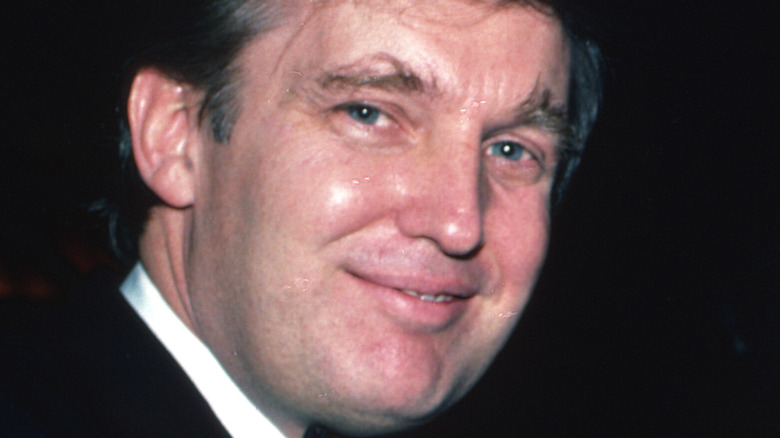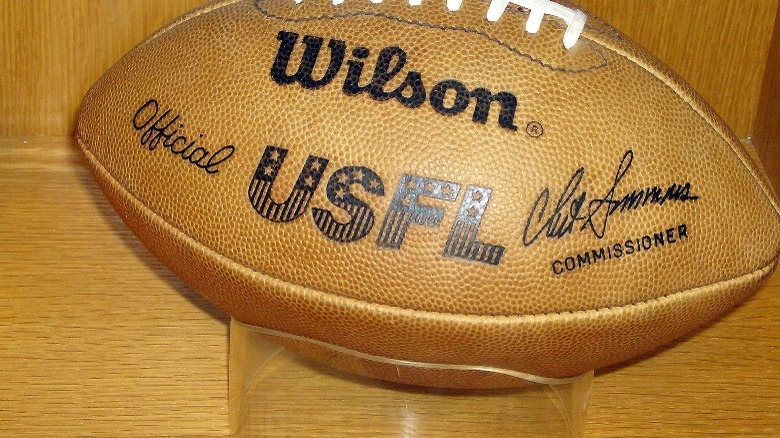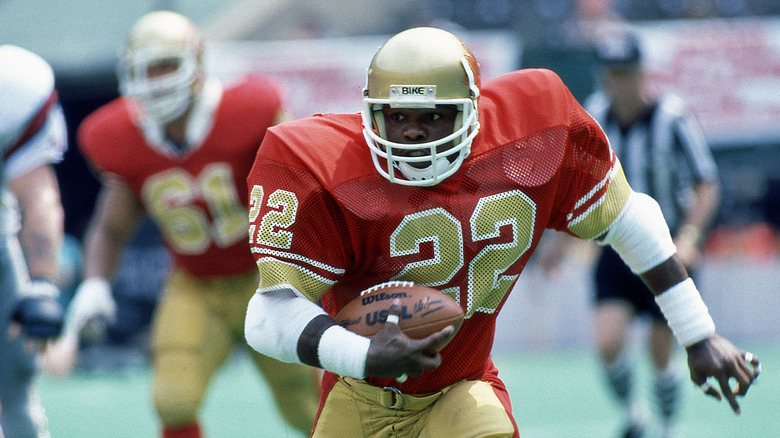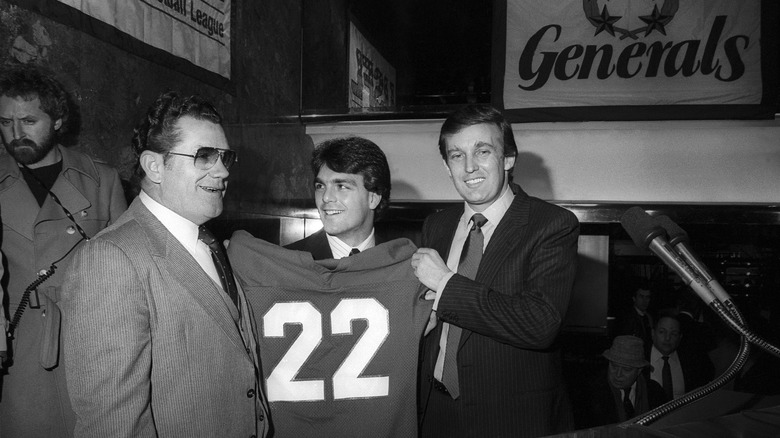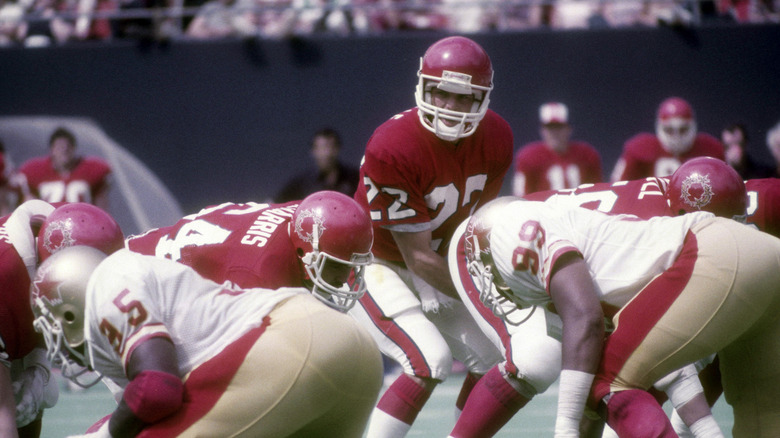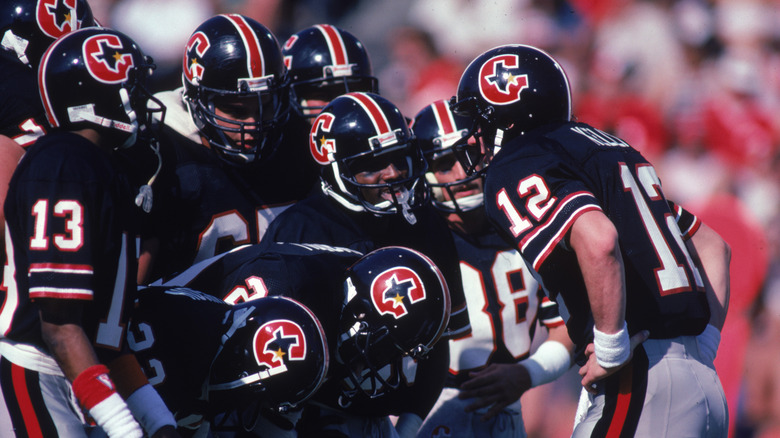The Truth About Donald Trump's Tenure As A Football Owner In The USFL
There have been numerous attempts to overthrow — or at the very least, coexist — with the preestablished top dog in a sport. For a lot of these leagues, the best-case scenario is a merger. The ABA with the NBA, the AFL with the NFL, or the WHA with the NHL. If that doesn't pan out, the chances of the league having to fold are high.
In the 1980s, a new upstart football league was formed. It was called the United States Football League, or USFL. Once again illustrating how hard it is to compete with an existing major league, the USFL is considered the NFL's biggest competitor, despite only lasting three years and losing $163 million, per Bleacher Report.
One of the league's biggest lasting legacies had to do with one of its key figures. Years before taking office as the 45th President of the United States, Donald Trump was heavily involved in the USFL and was the owner of one of the league's franchises, the New Jersey Generals. In addition to his role as an owner, Trump also played a part in the league's anti-trust lawsuit against the NFL that led to the downfall of the USFL, per The Guardian.
The idea for the USFL
The USFL was the brainchild of a man who had already found success bringing football to a new city. David Dixon as an antiques dealer who hailed from New Orleans and was a major player in bringing NFL football to town when the New Orleans Saints started play in 1965. Even today, football is thought of as a fall game, but according to Bleacher Report, Dixon thought it could work just as well on the other side of the calendar — as a spring sport as well.
Dixon's thought was that fans would still be hungry for football when the NFL and college football seasons came to a close. According to Pro Football Network, Dixon didn't just dive into the idea; instead, he sat back for 15 years and studied the failures of other upstart football leagues like the AFL and the World Football League, organizations that once tried to get a football in the sporting landscape but failed.
Once the 1980s arrived, Dixon hired a marketing firm to look into whether a spring football league was a viable business venture. Apparently he liked the results of the study, because he got 12 cities on board to host what would become USFL franchises. Fun fact: Nine of the cities were also home to NFL teams. He also struck a deal with ABC and ESPN to broadcast the league's games. The TV deal brought the league $13 million for the inaugural season, and then $14 million for the following two seasons.
The USFL Debuts
The teams that made up the USFL's original 12 were the Arizona Wranglers, Birmingham Stallions, Boston Breakers, Chicago Blitz, Denver Gold, Los Angeles Express, Michigan Panthers, New Jersey Generals, Oakland Invaders, Philadelphia Stars, Tampa Bay Bandits, and Washington Federals (via Pro Football Network). According to Bleacher Report, the league had a respectable first season, during which its teams managed to draw an average of just over 25,000 fans per game.
According to the Pro Football Hall of Fame, the league's inaugural champions were the Michigan Panthers (the USFL Championship Trophy is currently part of the Hall of Fame's collection). Yet despite a respectable debut, the league wasn't without its problems. Some teams had issues with ownership or with their home stadiums. This led to some instability with the league's franchises — with some folding and others relocating — something that plagued the league all three seasons it was in existence.
Some teams needed new owners after the 1983 season, and according to ESPN, one of them was the New Jersey Generals. That's when Donald Trump stepped in,
Trump in the USFL
According to Stats Crew, the year before Trump purchased the team, the New Jersey Generals posted a 6-12 record that made them one of the league's basement dwellers, with just the Washington Federals and Arizona Wranglers having worse records. Trump bought the team from previous owner J. Walter Duncan, an oil baron who lived in Oklahoma and rarely if ever made it to games. Trump was just 37 years old when he took control of the Generals.
Trump went to work immediately, according to ESPN, and brought in New York Jets coach Walt Michaels and signed a slew of NFL players. These moves completely reversed the Generals' fortunes, as they went 14-4 in 1984 and then 11-7 in 1985. However, both seasons ended with the team making quick first-round exits come playoff time. There were even rumors that Trump nearly signed legendary Miami Dolphins coach Don Shula, but didn't want to agree to one of Shula's terms: an apartment in Trump Tower.
Despite the on-field success, Trump isn't remembered fondly when it comes to his time as an owner, and that has more to do with his influence over his fellow owners and the USFL as a whole. According to The Guardian, many credit Trump with single-handedly destroying the league.
Trump's Hail Mary to save the USFL
It's important to note that Trump didn't intentionally try to tank the league — at least, not entirely. He championed a decision that just about anyone would agree was a death sentence for the USFL. That decision was for the USFL to switch from a spring schedule to one in the fall. This would put them in direct competition with the NFL and flew in the face of Dixon's original idea for the league, but that was the point. It's now thought that Trump's endgame for this decision was to force the NFL to merge with the USFL, but that's not what happened.
According to ESPN, Trump convinced fellow owners to move the season, saying that "If God wanted football in the spring, he wouldn't have created baseball." However, the league ran into a major stumbling block immediately. TV networks already had contracts with the NFL and didn't want to sign deals with a league rival playing a concurrent season. This left the USFL without a major source of revenue. So, they decided to file an anti-trust lawsuit against the NFL. The USFL thought this would be the catalyst for a merger, and if that didn't pan out, they assumed the league would walk away with a decent settlement to help several teams that were hitting financial difficulties.
The lawsuit and the demise of the USFL
The leagues went to court over the suit, and according to The Guardian, the NFL's legal team let the USFL layout their case before they started punching holes in it. While the USFL tried to paint themselves as an underdog, wronged by the football establishment, lead attorney for the NFL Frank Rothman crafted the argument that their position was patently false, and that Donald Trump — one of the richest men in the country — was no underdog in this situation. He also argued that every problem the USFL had faced had nothing to do with the NFL, but was instead self-inflicted.
The jury ruled in favor of the USFL, but what they received in damages was nowhere what they needed to save the league: all of $3. Undeterred, plans went ahead for the 1986 season, with Trump's Generals merging with the Houston Gamblers to form what was called a USFL "dream team." According to ESPN, the team — which would've featured soon-to-be NFL standouts Kim Kelly and Herschel Walker — was deemed "probably the best team in football," but we'll never know if that was true or not, because the league folded before the 1986 season could get started.
